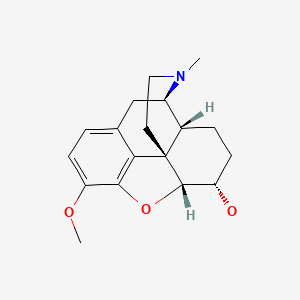Attribution Statement: LactMed is a registered trademark of the U.S. Department of Health and Human Services.
NCBI Bookshelf. A service of the National Library of Medicine, National Institutes of Health.
Drugs and Lactation Database (LactMed®) [Internet]. Bethesda (MD): National Institute of Child Health and Human Development; 2006-.
CASRN: 125-28-0

Drug Levels and Effects
Summary of Use during Lactation
Maternal use of oral opioids during breastfeeding can cause infant drowsiness, which may progress to rare but severe central nervous system depression. Like codeine, pharmacogenetics probably plays a role in the extent of central nervous system depression with dihydrocodeine. Newborn infants seem to be particularly sensitive to the effects of even small dosages of narcotic analgesics. Dihydrocodeine possibly caused severe respiratory depression in one newborn infant whose mother was taking the drug for cough. If dihydrocodeine is required by the mother of a newborn, it is not a reason to discontinue breastfeeding; however, once the mother's milk comes in, it is best to provide pain control with a nonnarcotic analgesic and limit maternal intake of dihydrocodeine to 2 to 3 days at a low dosage with close infant monitoring. If the baby shows signs of increased sleepiness (more than usual), difficulty breastfeeding, breathing difficulties, or limpness, a physician should be contacted immediately. Because there is little published experience with dihydrocodeine during breastfeeding, an alternate drug may be preferred, especially while nursing a newborn or preterm infant.
Drug Levels
Dihydrocodeine is metabolized via CYP2D6 to the active metabolite, dihydromorphine, which has a potency similar to morphine. Other weakly active metabolites include nordihydrocodeine, which is formed via CYP3A4, and dihydrocodeine-6-glucuronide. Both dihydrocodeine and dihydrocodeine-6-glucuronide are excreted renally.[1]
Maternal Levels. Relevant published information was not found as of the revision date.
Infant Levels. Relevant published information was not found as of the revision date.
Effects in Breastfed Infants
A woman began taking dihydrocodeine drops for cough twice daily (5.28 mg) beginning on the first day postpartum. One day later, her breastfed infant was difficult to arouse and was not breastfeeding well. The infant had bradycardia, hypoglycemia, and an oxygen saturation of 85%. After 24 hours in the hospital, all symptoms resolved. The symptoms were possibly caused by dihydrocodeine in milk.[2]
Effects on Lactation and Breastmilk
Narcotics can increase serum prolactin.[3] However, the prolactin level in a mother with established lactation may not affect her ability to breastfeed.
Alternate Drugs to Consider
(Analgesia) Acetaminophen, Butorphanol, Hydromorphone, Ibuprofen, Morphine; (Antitussive) Dextromethorphan
References
- 1.
- Kirkwood LC, Nation RL, Somogyi AA. Characterization of the human cytochrome P450 enzymes involved in the metabolism of dihydrocodeine. Br J Clin Pharmacol 1997;44:549-55. [PMC free article: PMC2042888] [PubMed: 9431830]
- 2.
- Eleftheriou G, Butera R, Davanzo F, Farina ML. Dihydrocodeine and breast feeding: A case report. Birth Defects Res A Clin Mol Teratol 2014;100:540.
- 3.
- Tolis G, Dent R, Guyda H. Opiates, prolactin, and the dopamine receptor. J Clin Endocrinol Metab 1978;47:200-3. [PubMed: 263291]
Substance Identification
Substance Name
Dihydrocodeine
CAS Registry Number
125-28-0
Disclaimer: Information presented in this database is not meant as a substitute for professional judgment. You should consult your healthcare provider for breastfeeding advice related to your particular situation. The U.S. government does not warrant or assume any liability or responsibility for the accuracy or completeness of the information on this Site.
- User and Medical Advice Disclaimer
- Drugs and Lactation Database (LactMed) - Record Format
- LactMed - Database Creation and Peer Review Process
- Fact Sheet. Drugs and Lactation Database (LactMed)
- Drugs and Lactation Database (LactMed) - Glossary
- LactMed Selected References
- Drugs and Lactation Database (LactMed) - About Dietary Supplements
- Breastfeeding Links
- PMCPubMed Central citations
- PubChem SubstanceRelated PubChem Substances
- PubMedLinks to PubMed
- Review Hydromorphone.[Drugs and Lactation Database (...]Review Hydromorphone.. Drugs and Lactation Database (LactMed®). 2006
- Review Oxymorphone.[Drugs and Lactation Database (...]Review Oxymorphone.. Drugs and Lactation Database (LactMed®). 2006
- Review Hydrocodone.[Drugs and Lactation Database (...]Review Hydrocodone.. Drugs and Lactation Database (LactMed®). 2006
- Review Morphine.[Drugs and Lactation Database (...]Review Morphine.. Drugs and Lactation Database (LactMed®). 2006
- Review Pentazocine.[Drugs and Lactation Database (...]Review Pentazocine.. Drugs and Lactation Database (LactMed®). 2006
- Dihydrocodeine - Drugs and Lactation Database (LactMed®)Dihydrocodeine - Drugs and Lactation Database (LactMed®)
Your browsing activity is empty.
Activity recording is turned off.
See more...
